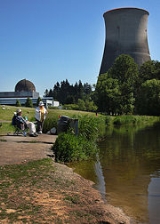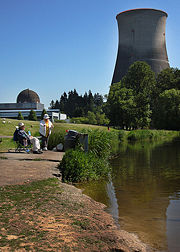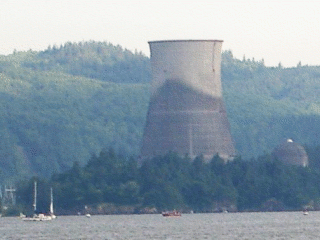
Trojan Nuclear Power Plant
Encyclopedia
Trojan Nuclear Power Plant was a pressurized water reactor
nuclear power plant
located southeast of Rainier
, Oregon
, United States
, and the only commercial nuclear power plant to be built in Oregon. After sixteen years of service it was closed by its operator, Portland General Electric
(PGE), almost twenty years before the end of its design lifetime. Decommissioning and demolition of the plant began in 1993 and was completed in 2006.
While operating, Trojan represented more than 12% of the electrical generation capacity of Oregon. For comparison, more than 80% of Oregon's electricity came from hydropower
from dams on the Columbia
and Snake River
s, with the rest mainly from fossil fuel
s. The site lies directly south of the small city of Prescott
, on the banks of the Columbia River
.
was achieved on December 15, 1975 and grid connection
on December 23, 1975. Commercial operation began on May 20, 1976 under a 35-year license to expire in 2011. The single 1130 megawatt
unit at Trojan was then the largest pressurized water reactor built. It cost $450 million to build the plant.
Environmental opposition dogged Trojan from its inception, and the opposition included non-violent protests organized by the Trojan Decommissioning Alliance. The Alliance organized the first major direct action
protest at Trojan in August 1977, and a second round of protests took place that November. Scores of demonstrators were arrested, and in December 1977 a jury found 96 protesters not guilty of criminal trespass.
There was another protest in August 1978, which led to about 280 arrests.
 In 1978, the plant was closed for nine months while modifications were made to improve its resistance to earthquakes. This followed the discovery both of major building construction errors and of the close proximity of a previously unknown faultline . The operators sued the builders, and an undisclosed out-of-court settlement was eventually reached.
In 1978, the plant was closed for nine months while modifications were made to improve its resistance to earthquakes. This followed the discovery both of major building construction errors and of the close proximity of a previously unknown faultline . The operators sued the builders, and an undisclosed out-of-court settlement was eventually reached.
The Trojan steam generators were designed to last the life of the plant, but it was only four years before premature cracking of the steam tubes was observed.
In the 1980 Oregon election, a ballot measure to ban construction of further nuclear power plants in the state without federally approved waste facilities was approved by the voters 608,412 (53.2%) to 535,049 (46.8%). In 1986, a ballot measure initiated by Lloyd Marbet for immediate closure of the Trojan plant was failed 35.7% yes to 64.3% no. This proposal was resubmitted in 1990, and again in 1992 when a similar proposal (by Jerry and Marilyn Wilson) to close the plant was also included. Each measure was soundly defeated by vote margins over 210,000 votes. Although all closure proposals were defeated, the plant operators committed to successively earlier closure dates for the plant.
 In 1992, Portland General Electric
In 1992, Portland General Electric
(PGE) spent $4.5 million to defeat ballot measures seeking to close Trojan. It was the most expensive ballot measure campaign in Oregon history until the tobacco industry spent $12 million in 2007 to defeat Measure 50
. A week later the Trojan plant suffered another steam generator tube leak of radioactive water, and was shut down. It was announced that replacement of the steam generators would be necessary. In December 1992, documents were leaked from the U.S. Nuclear Regulatory Commission showing that staff scientists believed that Trojan might be unsafe to operate. In January 1993, chief plant engineer David Fancher, acting as spokesman for PGE, announced the company would not try to restart Trojan.
The spent fuel was transferred from cooling pools to 34 concrete and steel storage casks in 2003.
In 2005, the reactor vessel
and other radioactive equipment were removed from the Trojan plant, encased in concrete foam, shrink-wrapped, and transported intact by barge along the Columbia River to Hanford Nuclear Reservation in Washington, where it was buried in a 45 feet (13.7 m) pit and covered with 6 inches (15.2 cm) of gravel, which made it the first commercial reactor to be moved and buried whole. The spent fuel is stored onsite in 34 dry casks
. It was awaiting transport to the Yucca Mountain Repository until that project was canceled in 2009.
The iconic 499 feet (152.1 m) cooling tower
, visible from Interstate 5 in Washington
and U.S. Route 30 in Oregon, was demolished via dynamite
implosion
at 7:00 a.m. on May 21, 2006. This event marked the first implosion of a cooling tower
at a nuclear plant in the United States. Additional demolition work on the remaining structures continued through 2008. The central office building, and the reactor building were demolished by Northwest Demolition and Dismantling in 2008. Remaining are five buildings: two warehouses, a small building on the river side, a guard shack, and offices outside the secured facility. There is also extensive underground infrastructure still to be demolished. It is expected that demolition of the plant will cost as least as much as its construction.
located at the power plant.
Pressurized water reactor
Pressurized water reactors constitute a large majority of all western nuclear power plants and are one of three types of light water reactor , the other types being boiling water reactors and supercritical water reactors...
nuclear power plant
Nuclear power plant
A nuclear power plant is a thermal power station in which the heat source is one or more nuclear reactors. As in a conventional thermal power station the heat is used to generate steam which drives a steam turbine connected to a generator which produces electricity.Nuclear power plants are usually...
located southeast of Rainier
Rainier, Oregon
Rainier is a city in Columbia County, Oregon, United States. The population was 1,687 at the 2000 census. Rainier is located on the south bank of the Columbia River across from Kelso and Longview, Washington-History:...
, Oregon
Oregon
Oregon is a state in the Pacific Northwest region of the United States. It is located on the Pacific coast, with Washington to the north, California to the south, Nevada on the southeast and Idaho to the east. The Columbia and Snake rivers delineate much of Oregon's northern and eastern...
, United States
United States
The United States of America is a federal constitutional republic comprising fifty states and a federal district...
, and the only commercial nuclear power plant to be built in Oregon. After sixteen years of service it was closed by its operator, Portland General Electric
Portland General Electric
Portland General Electric is an electrical utility based in Portland in the U.S. state of Oregon. It distributes electricity to customers in parts of Multnomah, Clackamas, Marion, Yamhill, Washington, and Polk counties - half of the inhabitants of Oregon...
(PGE), almost twenty years before the end of its design lifetime. Decommissioning and demolition of the plant began in 1993 and was completed in 2006.
While operating, Trojan represented more than 12% of the electrical generation capacity of Oregon. For comparison, more than 80% of Oregon's electricity came from hydropower
Hydropower
Hydropower, hydraulic power, hydrokinetic power or water power is power that is derived from the force or energy of falling water, which may be harnessed for useful purposes. Since ancient times, hydropower has been used for irrigation and the operation of various mechanical devices, such as...
from dams on the Columbia
Columbia River
The Columbia River is the largest river in the Pacific Northwest region of North America. The river rises in the Rocky Mountains of British Columbia, Canada, flows northwest and then south into the U.S. state of Washington, then turns west to form most of the border between Washington and the state...
and Snake River
Snake River
The Snake is a major river of the greater Pacific Northwest in the United States. At long, it is the largest tributary of the Columbia River, the largest North American river that empties into the Pacific Ocean...
s, with the rest mainly from fossil fuel
Fossil fuel
Fossil fuels are fuels formed by natural processes such as anaerobic decomposition of buried dead organisms. The age of the organisms and their resulting fossil fuels is typically millions of years, and sometimes exceeds 650 million years...
s. The site lies directly south of the small city of Prescott
Prescott, Oregon
Prescott is a city in Columbia County, Oregon, United States. It was named in 1905 for the owner of the local sawmill. The population was 72 at the 2000 census.-Geography:According to the United States Census Bureau, the city has a total area of , all land....
, on the banks of the Columbia River
Columbia River
The Columbia River is the largest river in the Pacific Northwest region of North America. The river rises in the Rocky Mountains of British Columbia, Canada, flows northwest and then south into the U.S. state of Washington, then turns west to form most of the border between Washington and the state...
.
History
Construction of Trojan began February 1, 1970. First criticalityCritical mass
A critical mass is the smallest amount of fissile material needed for a sustained nuclear chain reaction. The critical mass of a fissionable material depends upon its nuclear properties A critical mass is the smallest amount of fissile material needed for a sustained nuclear chain reaction. The...
was achieved on December 15, 1975 and grid connection
Grid connection
In electrical grids, a power system network integrates transmission grids, distribution grids, distributed generators and loads that have connection points called busses. A bus in home circuit breaker panels is much smaller than those used on the grid, where busbars can be 50 mm in diameter...
on December 23, 1975. Commercial operation began on May 20, 1976 under a 35-year license to expire in 2011. The single 1130 megawatt
Watt
The watt is a derived unit of power in the International System of Units , named after the Scottish engineer James Watt . The unit, defined as one joule per second, measures the rate of energy conversion.-Definition:...
unit at Trojan was then the largest pressurized water reactor built. It cost $450 million to build the plant.
Environmental opposition dogged Trojan from its inception, and the opposition included non-violent protests organized by the Trojan Decommissioning Alliance. The Alliance organized the first major direct action
Direct action
Direct action is activity undertaken by individuals, groups, or governments to achieve political, economic, or social goals outside of normal social/political channels. This can include nonviolent and violent activities which target persons, groups, or property deemed offensive to the direct action...
protest at Trojan in August 1977, and a second round of protests took place that November. Scores of demonstrators were arrested, and in December 1977 a jury found 96 protesters not guilty of criminal trespass.
There was another protest in August 1978, which led to about 280 arrests.

The Trojan steam generators were designed to last the life of the plant, but it was only four years before premature cracking of the steam tubes was observed.
In the 1980 Oregon election, a ballot measure to ban construction of further nuclear power plants in the state without federally approved waste facilities was approved by the voters 608,412 (53.2%) to 535,049 (46.8%). In 1986, a ballot measure initiated by Lloyd Marbet for immediate closure of the Trojan plant was failed 35.7% yes to 64.3% no. This proposal was resubmitted in 1990, and again in 1992 when a similar proposal (by Jerry and Marilyn Wilson) to close the plant was also included. Each measure was soundly defeated by vote margins over 210,000 votes. Although all closure proposals were defeated, the plant operators committed to successively earlier closure dates for the plant.

Portland General Electric
Portland General Electric is an electrical utility based in Portland in the U.S. state of Oregon. It distributes electricity to customers in parts of Multnomah, Clackamas, Marion, Yamhill, Washington, and Polk counties - half of the inhabitants of Oregon...
(PGE) spent $4.5 million to defeat ballot measures seeking to close Trojan. It was the most expensive ballot measure campaign in Oregon history until the tobacco industry spent $12 million in 2007 to defeat Measure 50
Oregon Ballot Measure 50 (2007)
Ballot Measure 50 was a legislatively-referred state statute ballot measure for the November 6, 2007 special election ballot in the state of Oregon. This measure would have increased the tobacco tax and dedicated the new revenue to providing health care for children, low-income adults and other...
. A week later the Trojan plant suffered another steam generator tube leak of radioactive water, and was shut down. It was announced that replacement of the steam generators would be necessary. In December 1992, documents were leaked from the U.S. Nuclear Regulatory Commission showing that staff scientists believed that Trojan might be unsafe to operate. In January 1993, chief plant engineer David Fancher, acting as spokesman for PGE, announced the company would not try to restart Trojan.
The spent fuel was transferred from cooling pools to 34 concrete and steel storage casks in 2003.
In 2005, the reactor vessel
Reactor vessel
In a nuclear power plant, the reactor vessel is a pressure vessel containing the Nuclear reactor coolant and reactor core.Not all power reactors have a reactor vessel. Power reactors are generally classified by the type of coolant rather than by the configuration of the reactor vessel used to...
and other radioactive equipment were removed from the Trojan plant, encased in concrete foam, shrink-wrapped, and transported intact by barge along the Columbia River to Hanford Nuclear Reservation in Washington, where it was buried in a 45 feet (13.7 m) pit and covered with 6 inches (15.2 cm) of gravel, which made it the first commercial reactor to be moved and buried whole. The spent fuel is stored onsite in 34 dry casks
Dry cask storage
Dry cask storage is a method of storing high-level radioactive waste, such as spent nuclear fuel that has already been cooled in the spent fuel pool for at least one year.. These casks are typically steel cylinders that are either welded or bolted closed. When inside, the fuel rods are surrounded...
. It was awaiting transport to the Yucca Mountain Repository until that project was canceled in 2009.
The iconic 499 feet (152.1 m) cooling tower
Cooling tower
Cooling towers are heat removal devices used to transfer process waste heat to the atmosphere. Cooling towers may either use the evaporation of water to remove process heat and cool the working fluid to near the wet-bulb air temperature or in the case of closed circuit dry cooling towers rely...
, visible from Interstate 5 in Washington
Interstate 5 in Washington
Interstate 5 in Washington is a highway in the U.S. state of Washington that extends from its border with Oregon to its border with Canada...
and U.S. Route 30 in Oregon, was demolished via dynamite
Dynamite
Dynamite is an explosive material based on nitroglycerin, initially using diatomaceous earth , or another absorbent substance such as powdered shells, clay, sawdust, or wood pulp. Dynamites using organic materials such as sawdust are less stable and such use has been generally discontinued...
implosion
Building implosion
In the controlled demolition industry, building implosion is the strategic placing of explosive material and timing of its detonation so that a structure collapses on itself in a matter of seconds, minimizing the physical damage to its immediate surroundings...
at 7:00 a.m. on May 21, 2006. This event marked the first implosion of a cooling tower
Cooling tower
Cooling towers are heat removal devices used to transfer process waste heat to the atmosphere. Cooling towers may either use the evaporation of water to remove process heat and cool the working fluid to near the wet-bulb air temperature or in the case of closed circuit dry cooling towers rely...
at a nuclear plant in the United States. Additional demolition work on the remaining structures continued through 2008. The central office building, and the reactor building were demolished by Northwest Demolition and Dismantling in 2008. Remaining are five buildings: two warehouses, a small building on the river side, a guard shack, and offices outside the secured facility. There is also extensive underground infrastructure still to be demolished. It is expected that demolition of the plant will cost as least as much as its construction.
Heliport
Trojan Heliport is a 60 x 60 ft. (18 x 18 m) private turf heliportHeliport
A heliport is a small airport suitable only for use by helicopters. Heliports typically contain one or more helipads and may have limited facilities such as fuel, lighting, a windsock, or even hangars...
located at the power plant.

